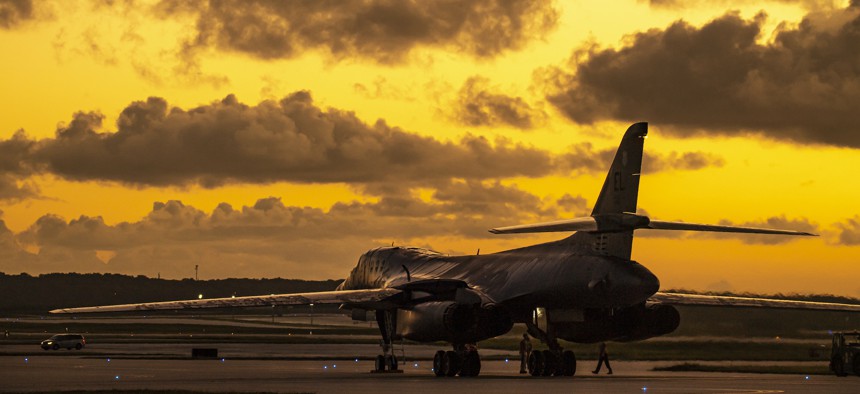
A U.S. Air Force B-1B Lancer attached to the 34th Bomb Squadron, Ellsworth Air Force Base, South Dakota, is inspected after a Bomber Task Force mission at Andersen Air Force Base, Guam, June 6, 2022. U.S. Air Force / Tech. Sgt. Chris Hibben
The Hardest Thing About Missile Defense in Guam? Finding the Right Site
There are candidate locations, but nothing is final, said Missile Defense Agency Director Vice Adm. Jon Hill.
The Missile Defense Agency is taking first steps for a facility—which will include a command and control center—in Guam as part of a long-term missile defense plan in the Indo-Pacific region. But choosing the right site has been one of the nascent program’s biggest challenges.
“So we learned a lot from Hawaii, that that radar was designed to really protect the islands from the rogue threat, which we know will continue to evolve and become more complex over time. Our issue became siting, and siting is tough,” particularly for long-range discrimination radar, Vice Adm. Jon Hill, the agency’s director, said during a Defense News webcast Aug. 12.
“That's a very constrained space. So we know that to be a fact. We know the sizing and the requirements on the sensors that we will need, we know where you can and cannot put live ordnance...that's always a constraining factor.”
The plan for Guam’s missile defense program, which has an increased carve out in the 2023 budget request, is to “lay down the basic architecture of the systems.”
So far, the agency has started environmental impact surveys and recently completed a visit focused on determining sites. Nothing is final, but, “we have a very good feel for at least technically and operationally where things should go in order for it to function as a system.”
Hill said he had a team on the island “for a couple of weeks,” and they met with leaders from Hawaii and Guam.
Guam is expected to be critical in future U.S. military efforts to deter China from attacking Taiwan, and would be within range of a long-range missile from the country. The Pentagon released plans earlier this year to bolster Guam’s defenses by 2028, though analysts have argued that the timeline should be accelerated. The U.S. has gradually added missile defense capabilities to the region, including land-based defenses such as the Terminal High Altitude Area Defense system, alongside ship-based interceptors and a myriad of sensors.
The ballistic missile defense and hypersonic missile defense capabilities from the MDA, combined with the Army’s cruise missile defense systems, will be integrated “into a command suite with command and control battle management on top of it,” Hill said.
“So you can think of a number of radars and ensure we meet the requirement, which is persistent, 360-degree coverage, right, because of the evolved threat, and it's an island in a very interesting geographical location. So that's what we're doing now, working very hard across the Army, Navy as the executive agent, on Guam.”




